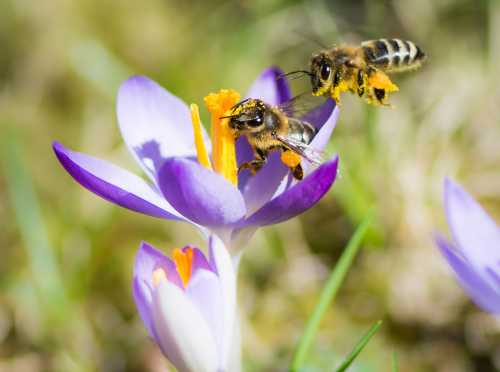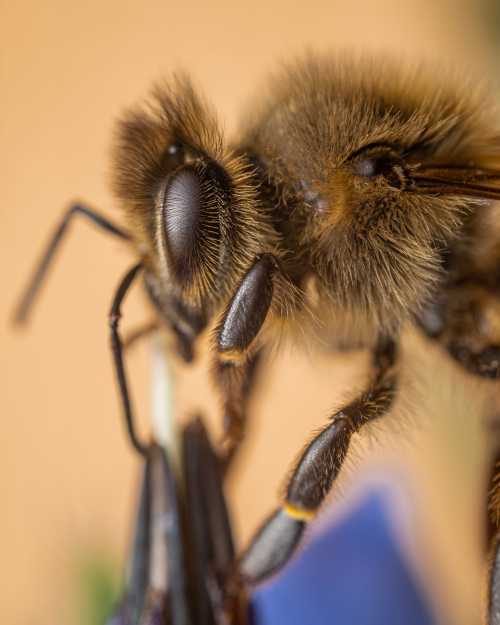Honey Bee Anatomy
Below is a diagram of honey bee anatomy for a worker bee. Scroll down the page for further explanatory notes.
Honey Bee Anatomy

The Head
- The hypopharyngeal gland and brain
The head of the honey bee contains the brain and also the hypopharyngeal gland. This is a tube-shaped organ which secretes a protein substance that is fed to larvae, queens and drones. It is important in the production of royal jelly.
- Eyes
All bees have 5 eyes.
2 compound eyes:
These are made up of many hexagonal facets, meaning that they can simultaneously see all around them (above, below, side to side, in front). Like humans, bees are trichromatic, but whereas humans base their vision on red, blue and green, bees base their colour vision on blue, green and UV. This means that some colour combinations visible to bees, are not visible to humans.
However, bees cannot see red, but they do visit red flowers because they can see the UV patterns within the petals.
Interestingly, honey bees have hairy compound eyes. This feature is relatively uncommon among bee species.
3 simple eyes (or ocelli):
The ocelli are 3 simple eyes positioned on top of the head. These eyes are sensitive to light, and aid the bee in its orientation.
- Antennae
Antennae are vitally important in all insects, and thus have to be kept clean through hygienic behaviour. You may have observed bees using their legs to clean and groom themselves, including their antennae.
Antennae are vital for touch, taste and smell. They are used for locating food, for sensing predators, and antennae even aid flight.
Antennae are also important for communication since they pick up signals such as pheromones and vibrations from other bees. - The Proboscis
This consists of the mouthparts, including a tongue which the bees use to suck nectar from flowers into the mouth.
Bees are classified as long or short-tongued, and honey bees fall into the long-tongued category.
Thorax
The thorax is the upper part of the body between the abdomen and head. There are 3 pairs of spiracles on the thorax (see below).
The thorax is the anchor for the legs. The hind legs also feature pollen baskets (or corbicula). The forelegs are used for cleaning the antennae.
There is a well-known saying 'the bee's knees'. In fact, bees really do have knees.
However, bees do not have toes, but instead have a tarsal claw. You can read more on the page: do bees have toes.
The thorax contains the flight muscles and salivary gland. There are 2 pairs of wings attached to the abdomen.
As with bumble bees, it is believed that honey bees beat their wings an amazing 200 times per second! See Honey Bee Facts.
Abdomen
Most of the spiracles are located along the sides of the abdomen. Spiracles are holes which are important for breathing. They enable oxygen to pass into the body (through the spiracles) and into the tracheal system.
The abdomen contains the honey stomach, also known as 'the crop'. The honey stomach enables the bee to carry about 75 mg of nectar from a flower back to the nest or hive.
Most of the process of digestion takes place in the midgut located in the abdomen.
The sting is a modified ovipositor (egg laying organ). Only females are able to sting, and do so only when they feel threat of attack.
The sting of a honey bee is barbed and is intended for stinging predators such as other insects, however, it is not adapted for stinging humans.
Thus to sting a human means death for the honey bee, since the barbed feature results in the sting becoming lodged in the skin, tearing the abdomen of the bee as it attempts to pull away.
The sting also houses ducts that secrete alarm pheromones.
Resources
- See links to other pages on this site for further information.
- Hung YS, Ibbotson MR. Ocellar structure and neural innervation in the honeybee. Front Neuroanat. 2014;8:6. Published 2014 Feb 19. doi:10.3389/fnana.2014.00006
If you found this page helpful or interesting, I'd really be grateful if you would share it with others - if not this page, perhaps another, such as Gardening For Bees.
Thank you so much :) .

